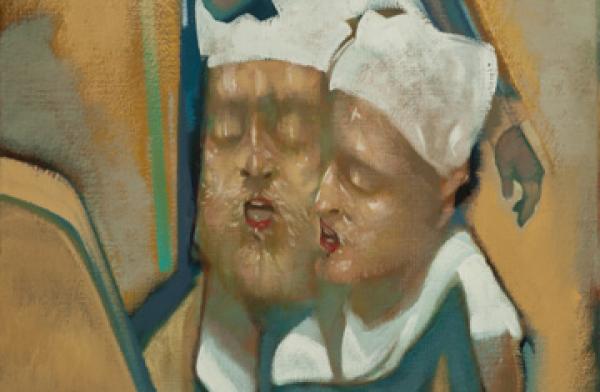Volume 14: Golden Voices in the Golden Land

September 04, 2012
PDF Download
They played to sold-out crowds across the country, toured internationally, and appeared regularly on the radio. The most popular commanded staggering concert fees, made hundreds of recordings, and drew zealous fans from Jewish and non-Jewish circles alike.
They were the cantors, or hazzanim, of the Golden Age of cantorial music in America, a period that spanned the first half of the 20th century. And while the primary role of these masters of Jewish liturgical song was to lead their congregations in prayer, their operatic voices and sheer musical charisma made them full-fledged musical superstars—inspiring the wide range of works, liturgical and otherwise, presented in Volume 14 from the Milken Archive of Jewish Music: The American Experience.
Many Golden Age cantors spent years honing their skills in Europe before emigrating to America. They brought with them a centuries-old tradition of cantorial art, or hazzanut, that emphasized subtly nuanced vocal improvisation over rich choral backgrounds.
You can hear that European heritage in the version of "Hosha na even sh'siya" by Moshe Ganchoff—a man who, ironically enough, acquired all of his musical skills right here in America.
Born in Odessa, Ganchoff was reared in Toledo and spent most of his career in New York City, where—when he wasn't touring, teaching or recording—he hosted a weekly radio show broadcasting folk and art songs in Yiddish and Hebrew, along with his own original liturgical pieces. (Many of the contemporary cantors whose voices are heard on this volume have similarly catholic tastes. Robert Bloch, for example, has performed Puccini and Bizet, while Simon Spiro has done musical theater and disco.)
Yet despite its Old World roots, the cantorial music of the Golden Age was uniquely American.But Ganchoff was steeped in the sound of the Eastern European khor shul, or choral synagogue, a highly refined idiom that informs American Jewish cantorial music to this day. For "Hosha na," he crafted a dignified yet impassioned treatment of the ancient Aramaic prayer and set it to stately choral accompaniment, investing the clearly enunciated text with the emotional intensity and ornamental flourish typical of Eastern European hazzanut.
For example, cantors had long been inspired by classical music, especially Italian opera. Yossele Rosenblatt, the most famous hazzan of the Golden Age (he made 200 recordings, enjoyed a rabid following even among non-Jewish audiences, and lent his voice to the very first talking film), had a taste for German lieder and modeled himself after the great Italian tenor Enrico Caruso. His "Uvnukho yomar," with its intimations of Verdi, would sound at home at La Scala.
Yet in America, many prominent cantors, including Joshua Lind, who tutored Moshe Ganchoff in New York—not to mention synagogue composers like Alexander Olshanetsky, Abraham Ellstein, and Herman Wohl, all of whom also wrote for the Yiddish theater (see Volume 13, "Great Songs of the American Yiddish Stage")—took their cues from Second Avenue.
Wohl, who for many years served as Yossele Rosenblatt's choir conductor, actually wrote "hayyom harat olam," with its bouncy choral introduction and sweetly harmonized accompaniment, for a musical that depicted a Rosh Hashanah service—only to use the piece for a real service at his own synagogue. And Lind's "Emet ve'emuna" contains snatches of original melody as tuneful as any show tune.
America also provided fertile ground for concert hazzanut: cantorial music that was either written expressly for public performance, or conceived as synagogue music and adapted for the concert stage.
American cantors and composers took advantage of the concert setting to indulge in longer, more extravagantly ornate vocal lines of the sort heard in Israel Schorr's "Sheyyibane beit hammikdash." First made famous by the Golden Age cantor Moshe Koussevitsky on a recording for RCA Victor, "Sheyyibane"is recreated here in all its rococo glory by cantor Benzion Miller, who serves the same Brooklyn congregation that Koussevitzky himself once did. (Visit the Milken Archive's virtual museum to see excerpts of "Sheyyibane" and other songs performed by Alberto Mizrahi, a protégé of Ganchoff who studied with Koussevitzky's youngest brother, David Kusevitsky.)
Unlike traditional synagogue performances, cantorial concerts often included non-liturgical pieces like Pierre Pinchik's "Der khazn un der gabe," a comical Yiddish song punctuated by virtuoso vocal acrobatics. They also provided an outlet for works with orchestral, rather than choral, accompaniment, allowing skilled arrangers like Ellstein ("V'li y'rushalayim irkha") to flex the full range of their musical muscles.
The Golden Age also saw the rise of concert choruses made up entirely of cantors: great flocks of liturgical songbirds, as many as one hundred at a time, performing works like Zavel Zilberts' "Al naharot bavel," a multi-sectional masterpiece that combines soaring cantorial melodies with the structural complexity and harmonic sophistication of "pure" art music.
The Golden Age of cantorial music in America ended shortly after the Second World War. But as Ganchoff, the last of the great Golden Age masters, said just two years before his death in 1997, "Hazzanut will survive because it is beautiful, and true beauty lives."
Wishful thinking? Maybe. But listening to contemporary torchbearers like Bloch, Miller, Mizrahi, and Spiro breathe fresh life into the music of their revered predecessors, Ganchoff's pronouncement takes on the bright ring of truth.
Founded in 1990 by philanthropist Lowell Milken, the Milken Archive of Jewish Music reflects the scope and variety of Jewish life in America. The Archive’s virtual museum www.milkenarchive.org is an interactive guide to music, videos, oral histories, photos and essays.
For information or interviews, contact media@milkenarchive.org.
Connect with us on Facebook at www.facebook.com/MilkenArchive and on Twitter at www.twitter.com/milkenarchive.
